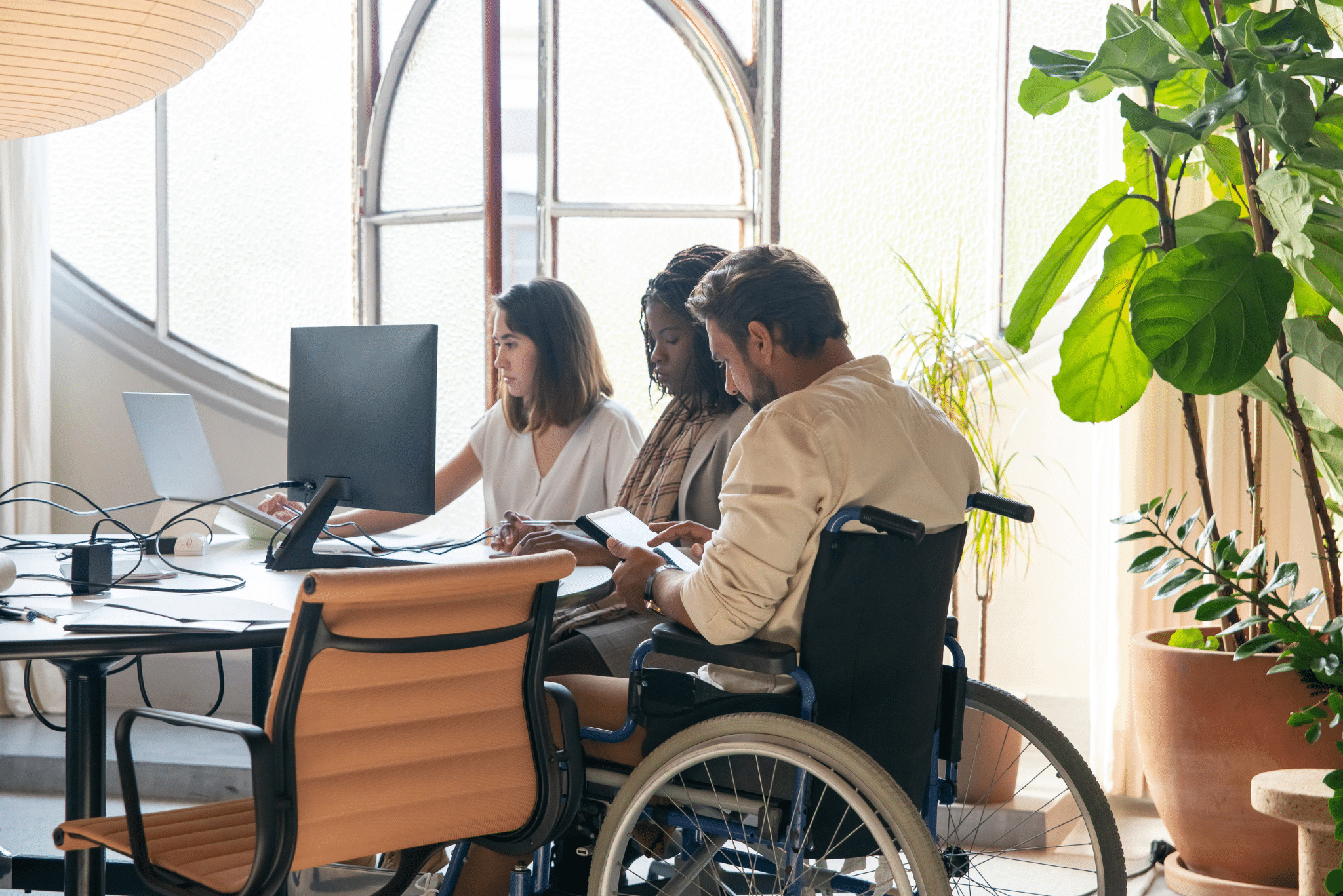4 Must-Dos for Cultivating Disability
Inclusion in the Workplace

When we talk about diversity, equity, and inclusion (DEI) in the workplace, discussions often center around race, gender, and sexual orientation. But disability inclusion and accessibility are also vitally important – and too often overlooked. This oversight not only silences a number of team members but also limits an organization’s ability to foster belonging for everyone. And this is particularly significant given that, according to the CDC, one in four adults in the U.S. lives with a disability.
It’s time we shift our practices to ensure that disability inclusion is no longer an afterthought, but a priority in building workplaces where everyone experiences belonging.
To make this happen, we’d like to offer you four must-dos for creating cultures that honor disability inclusion and accessibility.
4 Must-Dos for Cultivating Disability Inclusion in the Workplace
1. Shift from the Medical Model to the Social Model of Disability
As Prasanna Ranganathan, a renowned DEI and disability inclusion expert, shared with me during a recent conversation for bci’s Leadership Lens webinars, disability in the workplace has traditionally been understood through the medical model, which sees it as a personal “deficiency” in need of correction.
A more inclusive (and humane) approach is the social model of disability, which recognizes that disability arises based on how societies and the world are organized and structured – i.e. environmental barriers – and not individual “impairments.” As Prasanna explained: “The medical model of disability would say that my blindness is a flaw or a defect in me that needs to be fixed. The social model of disability, however, would say my disability arises in my interaction with the world around me, which was designed for people who see.”
This shift places the responsibility on organizations to design systems, spaces, and processes that reflect everyone’s needs versus penalizing individuals for their needs.
2. Actively Work to Interrupt Ableism in the Workplace
Ableism is a societal system that stigmatizes and oppresses those who live with disabilities by reinforcing the idea that people without disabilities are superior.
In the workplace, ableism manifests in various ways, creating barriers for professionals who live with disabilities and limiting their opportunities to succeed. Ablest inequities manifest in workplace policies, physical environments, and attitudes – whether it’s a lack of ramps and elevators, the absence of flexible work options, or the assumption that disabled employees are less capable.
These barriers profoundly reinforce exclusion by suppressing opportunity, striking at belonging, and more. Given this, it’s critical that we, as leaders, actively work to identify and address how ableism is impacting our workplace practices and processes.
3. Use Inclusive Language
Language not only shapes perception, it’s a tool for unlocking belonging, inclusion, and equity – and this includes disability inclusion. Here are a few key best practices to keep in mind when it comes to disability inclusion, as shared by Lorin MacDonald, a multiple award-winning disability inclusion expert and lawyer, during a recent bci webinar:
- Disability is not a bad word: So use it! Avoid euphemisms like “differently abled” or “challenged.” These terms can feel dismissive and obscure the lived experiences of people with disabilities.
- Person-first vs. identity-first: Some people prefer terms like “person with a disability,” while others identify as a “disabled person.” Both are valid – we want to tune into an individual’s preferences.
- Avoid pity and performative praise: Praising someone with a disability simply for existing, rather than for their contributions or achievements, can be condescending. Focus on acknowledging their work and skills, not their disability.
4. Build Inclusive Policies and Accessible Environments
According to the International Labour Organization, there is a significant gap globally in workforce participation between people who live with disabilities and those who don’t, which illustrates the ongoing challenges in creating accessible and inclusive employment opportunities.
A genuine commitment to disability inclusion means:
- Ensuring physical and digital spaces are accessible
- Providing tools such as screen readers and captioning software
- Accommodating flexible work arrangements
- Creating clear, safe processes for requesting accommodations
Equally important is regularly reviewing workplace policies to reflect evolving needs and best practices in disability inclusion.
These four must-dos are essential for creating experiences of belonging for persons with disabilities in the workplace. These principles aren’t about accommodations – they’re about unlocking inclusion, equity, engagement, empowerment, and advancement for all.
Let’s all work to ensure that disability inclusion isn’t an afterthought but a core part of our DEI programming and organizational values – one that shapes workplaces where everyone can thrive.
Do our words resonate with you? We would love to hear from you! Please send us a message through our Contact Us page, LinkedIn, or Instagram.
Reach out to the bci team here to learn more about our range of programming on cultivating belonging in the workplace, and check out the following resources that connect to disability inclusion:
- Articles:
- Disability in the workplace: Embracing disability diversity
- Do Your D&I Efforts Include People with Disabilities?
- Ableism: What It Means, History, Types, Examples, How It’s Harmful
- Disability Related Microaggressions
- The Harm of Ableist Language & What We Can Do About It
- The Power of Everyday Language to Cause Harm
- Resources & Guides:
- Assessment:
- TED Talks:
- bci Blogs:
- bci Tip Sheets:
- Ritu Worksheets:
- bci Playlists:
